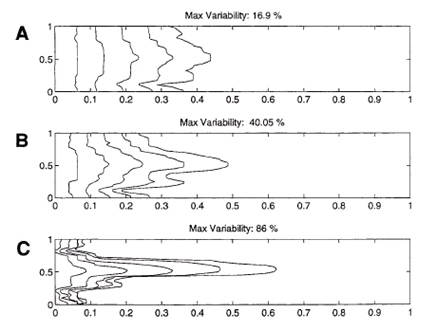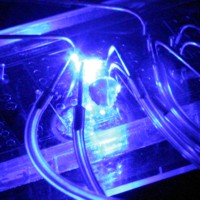Thrombolysis
 Blood clots form under hemodynamic conditions and can obstruct flow during angina, acute myocardial infarction, stroke, deep vein thrombosis, pulmonary embolism, peripheral thrombosis, or dialysis access graft thrombosis. Therapies to remove these clots through enzymatic and/or mechanical approaches require consideration of the biochemistry and structure of blood clots in conjunction with local transport phenomena. Because blood clots are porous objects exposed to local hemodynamic forces, pressure-driven interstitial permeation often controls drug penetration and the overall lysis rate of an occlusive thrombus. Reaction engineering and transport phenomena provide a framework to relate dosage of a given agent to potential outcomes. The design and testing of thrombolytic agents and the design of therapies must account for (a) the binding, catalytic, and systemic clearance properties of the therapeutic enzyme; (b) the dose and delivery regimen; (c) the biochemical and structural aspects of the thrombotic occlusion; (d) the prevailing hemodynamics and anatomical location of the thrombus; and (e) therapeutic constraints and risks of side effects. These principles also impact the design and analysis of local delivery devices. Blood clots form under hemodynamic conditions and can obstruct flow during angina, acute myocardial infarction, stroke, deep vein thrombosis, pulmonary embolism, peripheral thrombosis, or dialysis access graft thrombosis. Therapies to remove these clots through enzymatic and/or mechanical approaches require consideration of the biochemistry and structure of blood clots in conjunction with local transport phenomena. Because blood clots are porous objects exposed to local hemodynamic forces, pressure-driven interstitial permeation often controls drug penetration and the overall lysis rate of an occlusive thrombus. Reaction engineering and transport phenomena provide a framework to relate dosage of a given agent to potential outcomes. The design and testing of thrombolytic agents and the design of therapies must account for (a) the binding, catalytic, and systemic clearance properties of the therapeutic enzyme; (b) the dose and delivery regimen; (c) the biochemical and structural aspects of the thrombotic occlusion; (d) the prevailing hemodynamics and anatomical location of the thrombus; and (e) therapeutic constraints and risks of side effects. These principles also impact the design and analysis of local delivery devices.
Publications
| 1. |
1993 |
Diamond SL, Anand S. Inner clot diffusion and permeation during fibrinolysis. Biophys J 1993; 65 (6): 2622-2643  |
| 2. |
1994 |
Wu JH, Siddiqui K, Diamond SL. Transport phenomena and clot dissolving therapy: an experimental investigation of diffusion-controlled and permeation-enhanced fibrinolysis. Thromb Haemost 1994; 72 (1): 105-112  |
| 3. |
1995 |
Anand S, Wu JH, Diamond SL. Enzyme-Mediated Proteolysis of Fibrous Biopolymers - Dissolution Front Movement in Fibrin or Collagen under Conditions of Diffusive or Convective-Transport. Biotechnology and Bioengineering 1995; 48 (2): 89-107  |
| 4. |
|
Wu JH, Diamond SL. Fluorogenic Fibrinogen and Fibrin Facilitate Macromolecular Assembly and Dynamic Assay of Picomolar Levels of Plasminogen Activators under Well-Mixed Conditions. Thrombosis and Haemostasis 1995; 74 (2): 711-717  |
| 5. |
|
Wu JH, Diamond SL. A fluorescence quench and dequench assay of fibrinogen polymerization, fibrinogenolysis, or fibrinolysis. Anal Biochem 1995; 224 (1): 83-91  |
| 6. |
|
Wu JH, Diamond SL. Tissue plasminogen activator (tPA) inhibits plasmin degradation of fibrin. A mechanism that slows tPA-mediated fibrinolysis but does not require alpha 2-antiplasmin or leakage of intrinsic plasminogen. J Clin Invest 1995; 95 (6): 2483-2490  |
| 7. |
1996 |
Anand S, Diamond SL. Computer simulation of systemic circulation and clot lysis dynamics during thrombolytic therapy that accounts for inner clot transport and reaction. Circulation 1996; 94 (4): 763-774  |
| 8. |
1997 |
Anand S, Kudallur V, Pitman EB, Diamond SL. Mechanisms by which thrombolytic therapy results in nonuniform lysis and residual thrombus after reperfusion. Ann Biomed Eng 1997; 25 (6): 964-974  |
| 9. |
|
Diamond SL. Engineering Approaches for Thrombolytic Therapy. BMES Bulletin 1997; 21 : 3  |
| 10. |
1999 |
Diamond SL. Engineering design of optimal strategies for blood clot dissolution. Annu Rev Biomed Eng 1999; 1 : 427-462  |
| 11. |
2006 |
Ganguly K, Goel MS, Krasik T, Bdeir K, Diamond SL, Cines DB, Muzykantov VR, Murciano JC. Fibrin affinity of erythrocyte-coupled tissue-type plasminogen activators endures hemodynamic forces and enhances fibrinolysis in vivo. J Pharmacol Exp Ther 2006; 316 (3): 1130-1136  |
|





